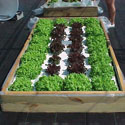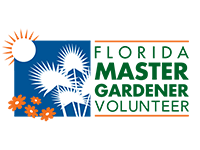The Neighborhood Gardener –
Floating Hydroponic Gardens
Try a fun gardening technique this summer by building a simple floating hydroponic garden. Hydroponic gardens consist of plants grown without soil. Instead, these plants are grown in a nutrient-rich solution. In the horticulture industry, these are used to produce a large amount of produce on small acreage.
You can also use this technique at home by using a few things from around your house. A floating garden is easy to build and can provide a large number of nutritious vegetables. Best of all, hydroponic gardens avoid weeds and other pest problems common to soil-grown vegetables.
Materials needed:
- Plastic children’s pool or other wide-mouthed bucket
- 1.5 inch thick Styrofoam
- Water to fill the pool
- Water-soluble fertilizer, such as 20-20-20 with micronutrients
- Epsom salts
- Net pots or Styrofoam coffee cups with slits cut in the bottom
- Hole saw or sharp knife
Steps:
- Fit the Styrofoam to the pool and make sure it has sufficient room to move up and down.
- Fill the pool with water to a total depth of at least 5 inches. Keep track of the total gallons of water you add.
- Add water-soluble fertilizer, such as 20-20-20 with micronutrients, at a rate of 2 teaspoons of fertilizer for each gallon of water used in the water garden.
- Add Epsom salt (magnesium sulfate) at a rate of one teaspoon for each gallon of water.
- Use a hole saw or sharp knife to cut holes in the Styrofoam. A 2.5-inch hole saw is needed to drill the correct-size holes into the Styrofoam when using 3-inch net pots. Use 1.75-inch hole saw for 2-inch net pots. Bigger plants like Swiss chard, cucumber, and cut flowers need bigger cups to keep them anchored in the water—otherwise they fall out. The hole size should allow the bottom of a cup to be level with the underside of the Styrofoam. It’s very important that cups do not extend lower than 1/16 inch below the bottom of the Styrofoam sheet. This allows the root mass to wick up water without being totally submerged.
- Place holes 6 inches from the sides and 12 inches apart.
- Place young starter transplants directly into the cups. Use toothpicks, if desired, to hold the transplant in an upright position. Do not remove the potting soil from the transplant. Do not add any potting mix or other material around the young transplant as this will keep the roots too wet and inhibit oxygen intake.
- Add extra water and fertilizer as needed to keep the Styrofoam sheet floating on a minimum of 5-inches of solution.
Crops
Leafy salad crops usually do well in hydroponic gardens. Transplants used in this system should be grown to be fully rooted in a typical soilless media. Transplants can be grown at home in many root ball shapes in a loose media, purchased from garden suppliers, or grown in compressed peat pellets.
Cool season choices
- Lettuce (romaine, Boston, bibb, and leafy lettuces)
- Mustard greens
- Mizuna
- Mint
- Kale
Warm season choices (Growing with floating systems does not override the normal challenges of gardening in the warm season in Florida.)
- Basil
- Swiss chard
- Cucumber
- Watercress
- Cut flowers (such as zinnia and sunflowers)
Light rainfall will have little effect on the water garden; only extensive flooding would require fertilizer adjustment based on the amount of water added by rainfall. The solution in the garden needs to be replaced periodically for optimum production. You can grow two crops of salad greens in the same solution before changing the entire solution and starting with a new batch.
Now, stand back and watch them grow. The care is easy. You won’t even need to water your plants, because they get everything they need from the nutrient solution.





